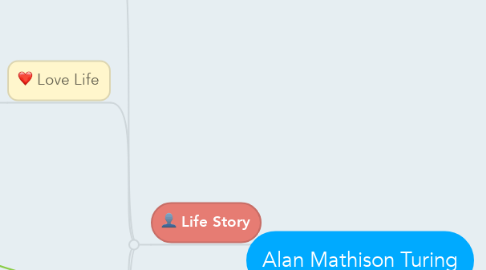
1. Contributions in...
1.1. Logic and Mathemathics
1.1.1. Studied the "Entscheidungsproblem" that says that every human though can be expressed like an algorythm, and says that that's not true. After that he says that there can be done a machine that does this using paper rolls with holes, theywere made and called "Turing Machines"
1.1.2. Debated with the Philosopher Ludwig Wittgestein around the role in mathematics in the path of truth, defending the view of formalism again Ludwig's posture on relativism
1.1.3. He got interested in mathematical biology, to the point he writes about morphogenesis and oscilating chemical reactions.
1.2. Cryptanalysis
1.2.1. He inspired the "Turingery" method on decoding through, that uses a teleprinter rotor cipher attachment and was used for the decode of Lorenz SZ 40/42.
1.2.2. The portable secure voice machine Delilah was enginereed by him and his work team during war.
1.3. Computing
1.3.1. Considered the father of the roll strip paper codes that where later used in computers.
1.3.2. He also is concerned in the development of Artificial Inteligent, as he designed a test named after him for trying to standarize the consideration of an "inteligent" machine.
1.4. War
1.4.1. Colaboured in WWII to decodify the orders of the nazi generals for the military and naval units using a machine that imited the functioning of the Enigma, it was the Bombe, based on the Polish Bomba.
1.4.2. It was part of a team of mathematicians called the H-8, that did not only the Enigma decodification but the deducing of the the indicator procedure used by the German navy; developing a more efficient use of the Banburismus; developing Turingery and Delilah.
2. Bibliography:
2.1. https://www.math.rutgers.edu/courses/436/Honors02/turing.html
2.2. https://en.wikipedia.org/wiki/Alan_Turing#Cryptanalysis
3. Life Story
3.1. Childhood and Education
3.1.1. He was born in June 23 of 1912, his father worked in the international relationships between England and Colonial India.
3.1.2. He proved to be a genius since the first years, he entered the Sherborne indepentent elite school at the age of 14, however the school did´t support Alan in his specialization for Sciences and mathematics.
3.2. Love Life
3.2.1. At his childhood he had a really strong relationship with his classmate Christopher Morcom, that is said to be his first love.
3.2.2. During his years in the decodification of war messages , he proposed marriage to his partner Joan Clarke, but then regret because he though he could not handle a marriage being homosexual
3.2.3. In 1952 he started a relationship with Arnold Murray, a 19 year-old unemployed man.
3.3. University and Adult Life
3.3.1. When he entered in Cambridge, he played special interest in the David Hilbert "Entscheidungsproblem"
3.3.2. During WWII he worked on Bletchley Park in cryptography, trying to colaborate in the decodification of the Nazi Germany war messages. Meanwhile he was an afficionate runner.
3.3.3. In 1945 he moved to Hampton, London where he started developing the ACE.
3.3.4. As in the 1950's homosexuality was rejected, he has condemned by the British Government an exiled from the USA.
3.4. Death and Recognition
3.4.1. Alan Turing died in June 8 of 1954, afther being poisoned with cyanide misteriously, some hipothesis suggest a suicide
3.4.2. After his death an Award an numerous institutional buildings are nemed after him. Even the Apple logo is said to resemble his death.
3.4.3. The British government concieved pardon about his sexual orientation in the new millenia.
